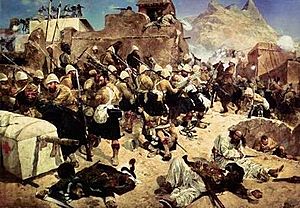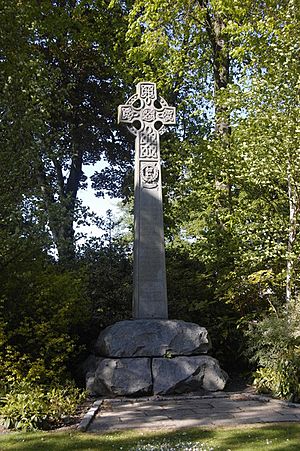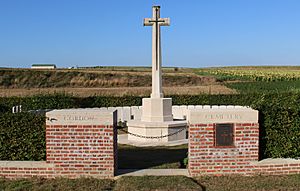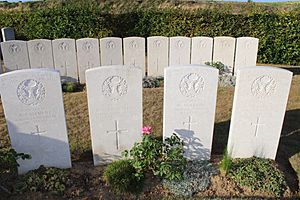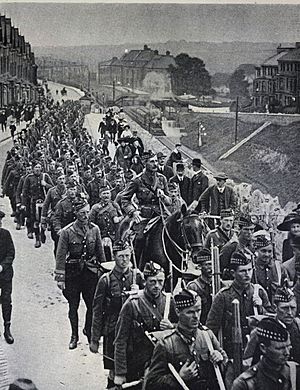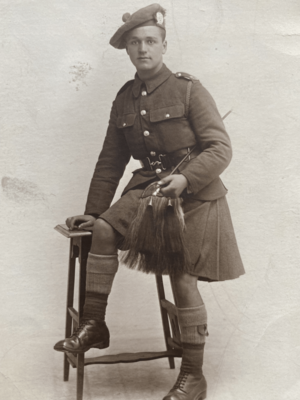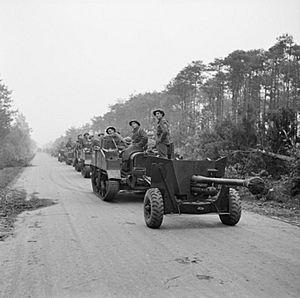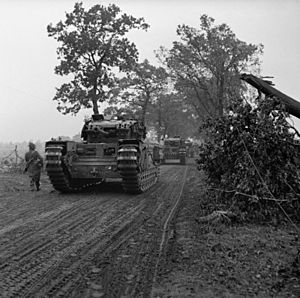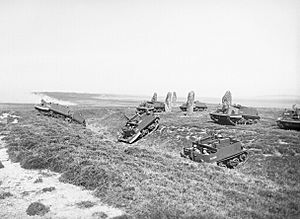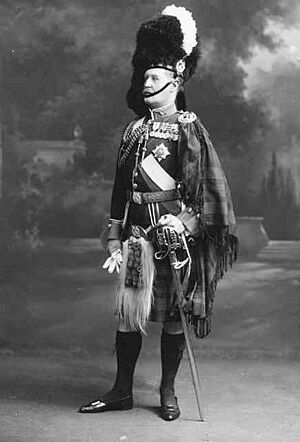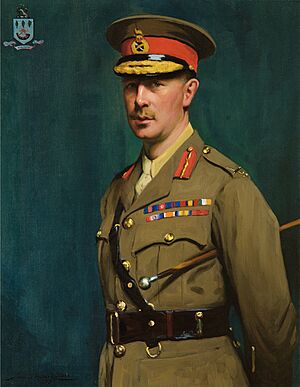Gordon Highlanders facts for kids
Quick facts for kids Gordon Highlanders |
|
|---|---|
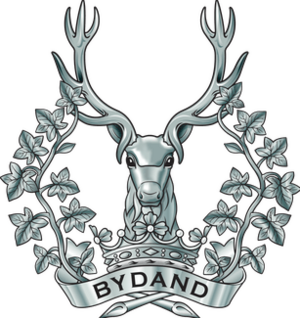
Cap badge of the Gordon Highlanders
|
|
| Active | 1881–1994 (as Gordon Highlanders) |
| Country | |
| Branch | |
| Type | Infantry |
| Size | Line infantry |
| Part of | Scottish Division |
| Garrison/HQ | Castlehill Barracks, Aberdeen (1881–1935) Gordon Barracks, Bridge of Don (1935–94) |
| Motto(s) | Bydand |
| March | Cock o' the North |
| Engagements | Mysore Seringapatam Peninsular War South Africa 1899–1902 |
| Battle honours | Relief of Ladysmith Battle of Kandahar |
| Commanders | |
| Ceremonial chief | King Edward VIII Henry William Frederick Albert, 1st Duke of Gloucester The Prince of Wales KG KT GCB AK QSO DC |
| Insignia | |
| Tartan |  |
The Gordon Highlanders was a famous infantry regiment (a large group of soldiers) in the British Army. It existed for 113 years, from 1881 until 1994. In 1994, it joined with another regiment, The Queen's Own Highlanders (Seaforth and Camerons), to create a new one called The Highlanders (Seaforth, Gordons and Camerons). Even though a group called the 'Gordon Highlanders' had been around since 1794, the official 'Gordon Highlanders Regiment' was formed in 1881. This happened when two older regiments, the 75th (Stirlingshire) Regiment of Foot and the 92nd (Gordon Highlanders) Regiment of Foot, combined.
Contents
History of the Regiment
How the Regiment Started
The Gordon Highlanders regiment officially began on 1 July 1881. It was part of a big army change called the Childers Reforms. The regiment was linked to the areas of Aberdeenshire, Banffshire, and Shetland in Scotland.
The regiment included two main regular battalions (groups of soldiers). It also had other units made up of local volunteers and militia (part-time soldiers).
- The 1st Battalion was made from the old 75th Regiment.
- The 2nd Battalion was made from the old 92nd Regiment.
The 1st Battalion fought in the Anglo-Egyptian War in September 1882 at the Battle of Tel el-Kebir. They also took part in the Nile Expedition to try and rescue Major-General Charles George Gordon during the Mahdist War.
Later, the 1st Battalion was involved in the Chitral Expedition and the Tirah Campaign. During a battle on the North West Frontier in October 1897, at the Dargai Heights, two very brave pipers earned special recognition. Piper George Findlater, even though he was shot in both legs, kept playing his bagpipes to encourage the soldiers. Piper John Kidd was also shot but sat up and continued to play "The Cock o' the North" as the troops charged forward.
Both battalions were sent to South Africa when the Second Boer War began in 1899. The 2nd Battalion fought at the Battle of Elandslaagte in October 1899. It also helped to end the Siege of Ladysmith in November 1899. The 1st Battalion arrived later and fought at the Battle of Magersfontein in December 1899. They also saw heavy fighting at Doornkop in May 1900. The 1st Battalion stayed in South Africa until the war ended in June 1902.
In 1908, the volunteer and militia groups were reorganized across the country. The regiment then had one reserve battalion and four territorial battalions (local volunteer groups).
The First World War (1914-1918)
When the First World War began, many Gordon Highlanders battalions were sent to fight.
Regular Army Battalions
The 1st Battalion was in Plymouth, England, when the war started. It went to France in August 1914. They fought the Germans at the Battle of Mons and then at the Battle of Le Cateau. After Le Cateau, most of the battalion was captured. However, it was rebuilt with new soldiers and continued to fight on the Western Front for the rest of the war.
The 2nd Battalion was in Egypt in 1914. It returned to England and then landed in Belgium in October 1914. They immediately saw action in the First Battle of Ypres. This battalion also served on the Western Front until November 1917. They then moved to Italy and were part of the final successful battle there, the Battle of Vittorio Veneto, in late 1918.
Territorial Force Battalions
Several territorial battalions also played a big part:
- The 1/4th (City of Aberdeen) Battalion arrived in France in February 1915.
- The 1/5th (Buchan and Formartin) Battalion arrived in France in May 1915.
- The 1/6th (Banff and Donside) Battalion also went to France. This battalion was involved in one of the longest Christmas truces of 1914, which lasted until January 3, 1915.
- The 1/7th (Deeside Highland) Battalion arrived in France in May 1915.
All these battalions served on the Western Front.
New Army Battalions
New battalions were formed to help with the war effort:
- The 8th (Service) Battalion arrived in France in May 1915.
- The 9th (Service) Battalion and the 10th (Service) Battalion arrived in France in July 1915.
These new battalions also fought on the Western Front.
A special 1st Garrison Battalion was formed in 1916. It was made up of soldiers who were not fit for front-line fighting. This battalion was sent to India and later took part in the Third Anglo-Afghan War.
The Second World War (1939-1945)
The Gordon Highlanders played a crucial role in the Second World War.
The 1st Battalion was sent to France in September 1939 as part of the British Expeditionary Force (BEF). In May 1940, during the Battle of France, they were trapped and many soldiers had to surrender at Saint-Valéry-en-Caux. However, the 1st Battalion was reformed in the UK in August 1940. They then fought in North Africa (including El Alamein), Tunisia, Sicily, and North-western Europe, ending the war in Germany.
The 2nd Battalion was in Malaya (now Malaysia) and fought in the Battle of Singapore in February 1942. They surrendered along with many other British Commonwealth soldiers. Sadly, more men from this battalion died as prisoners of war in Japanese camps than during the actual fighting. The 2nd Battalion was reformed in May 1942. They landed in Normandy, France, on 23 June 1944, and were involved in heavy fighting in Normandy, the Netherlands, and Germany.
The 4th (City of Aberdeen) Battalion fought in France. It later became an artillery regiment in 1941, called the 92nd Anti-Tank Regiment.
The 5th Battalion also went to France with the BEF. Like the 1st Battalion, many of its soldiers were forced to surrender at Saint-Valéry-en-Caux in 1940. The 5th Battalion was reformed in August 1940, combining with the 7th Battalion to become the 5th/7th Battalion. They served in North Africa and took part in the Normandy landings in 1944.
The 6th (Banffshire) Battalion took part in the Dunkirk evacuation in 1940, where many British soldiers were rescued from France. This battalion fought in the Tunisian, North African, and Italian campaigns, including the Battle of Anzio. They ended the war on duty in Palestine.
The 8th (City of Aberdeen) Battalion also became an artillery unit, the 100th Anti-Tank Regiment. This battalion served in the Burma Campaign.
The 9th (Strathbogie, Garioch and Strathdon) Battalion was based in the Orkney Islands from 1940-1941. In 1942, it became an armoured regiment, the 116th Regiment (Gordon Highlanders) Royal Armoured Corps. They still wore the Gordon Highlanders' cap badge and tartan. This regiment went to Burma in December 1944 and played a key role in defeating Japanese forces there.
After the Wars
After the Second World War, the Gordon Highlanders continued to serve. They saw action in the Malayan Emergency, Cyprus, and Northern Ireland.
On 17 September 1994, the regiment joined with The Queens' Own Highlanders (Seaforth and Camerons) to form The Highlanders (Seaforth, Gordons and Camerons). In 1997, the Gordon Highlanders Museum opened in Aberdeen, at the regiment's old headquarters.
Victoria Cross Heroes
The Victoria Cross is the highest award for bravery in the British military. Many Gordon Highlanders earned this medal for their amazing courage:
- Edward Lawson (India, 1897)
- George Findlater (India, 1897)
- Matthew Meiklejohn (Second Boer War, 1899)
- William Robertson (Second Boer War, 1899)
- Ernest Towse (Second Boer War, 1900)
- John Mackay (Second Boer War, 1900)
- William Gordon (Second Boer War, 1900)
- David Younger (Second Boer War, 1900)
- William Kenny (France, 1914)
- James Brooke (France, 1914)
- George McIntosh (France, 1917)
- Allan Ker (France, 1918)
- George Mitchell (Italy, 1944)
Regimental Honours
Battle Honours
Battle honours are special awards given to regiments for their bravery in battles. The Gordon Highlanders earned many, including:
- Early Wars: Mysore, South Africa 1835, Tel-El-Kebir, Egypt 1882, Nile 1884–5, Chitral, Tirah, Defence of Ladysmith, Paardeberg, South Africa, 1899–1902.
- The Great War (First World War): Mons, Le Cateau, Retreat from Mons, Marne 1914 '18, Aisne 1914, Ypres 1914 '15 '17, Somme 1916, 18, Arras 1917 '18, Passchendaele, Cambrai 1917 '18, France and Flanders 1914–18, Piave, Vittorio Veneto, Italy 1917–18.
- The Second World War: Dunkirk 1940, Somme 1940, St. Valery-en-Caux, Rhineland, North-West Europe 1940, '44–45, El Alamein, North Africa 1942–43, Landing in Sicily, Sicily 1943, Anzio, Rome, Italy 1944–45.
Sporting Honours
The regiment also won the Irish FA Cup in 1890, showing their skills off the battlefield too!
Important Leaders
Colonels-in-Chief
These were important royal figures who supported the regiment:
- 1898–: F.M. King Edward VII
- 1937–: F.M. Henry William Frederick Albert, Duke of Gloucester
- 1977–: Prince Charles, Prince of Wales
Regimental Colonels
These officers were the leaders of the regiment:
- 1881–1890: Gen. John Thomas Hill
- 1881–1884: Gen. Mark Kerr Atherley
- 1884–1895: Gen. Sir John Alexander Ewart
- 1895–1897: Lt-Gen. Charles Edward Parke Gordon
- 1897–1912: F.M. Sir George Stuart White
- 1912–1914: Gen. Sir Charles Whittingham Horsley Douglas
- 1914–1939: Gen. Sir Ian Standish Monteith Hamilton
- 1939–1948: Maj-Gen. Sir James Lauderdale Gilbert Burnett
- 1948–1958: Col. William James Graham
- 1958–1965: Brig. James Roderick Sinclair, 19th Earl of Caithness
- 1965–1978: Lt-Gen. Sir George C. Gordon Lennox
- 1978–1986: Lt-Gen. Sir John Richard Alexander Macmillan
- 1986–1994: Lt-Gen. Sir Peter Walter Graham
Alliances with Other Regiments
The Gordon Highlanders had special connections with other regiments around the world:
 Canada – The 48th Highlanders of Canada
Canada – The 48th Highlanders of Canada Canada – The Toronto Scottish Regiment (Queen Elizabeth The Queen Mother's Own)
Canada – The Toronto Scottish Regiment (Queen Elizabeth The Queen Mother's Own) Australia – 5th Battalion, The Victorian Scottish Regiment
Australia – 5th Battalion, The Victorian Scottish Regiment Australia – 5th and 6th Battalions, The Royal Victoria Regiment
Australia – 5th and 6th Battalions, The Royal Victoria Regiment Australia – 5th/7th Battalion, The Royal Australian Regiment
Australia – 5th/7th Battalion, The Royal Australian Regiment South Africa – The Cape Town Highlanders
South Africa – The Cape Town Highlanders


